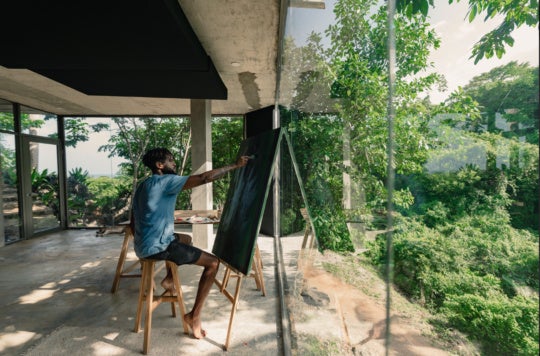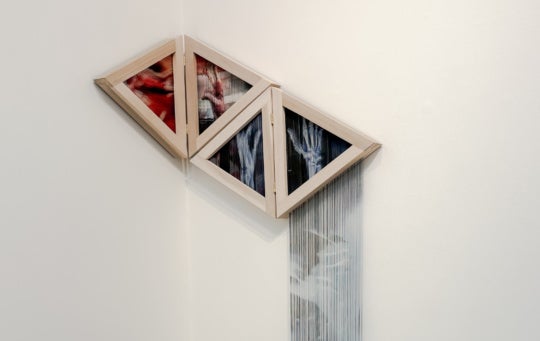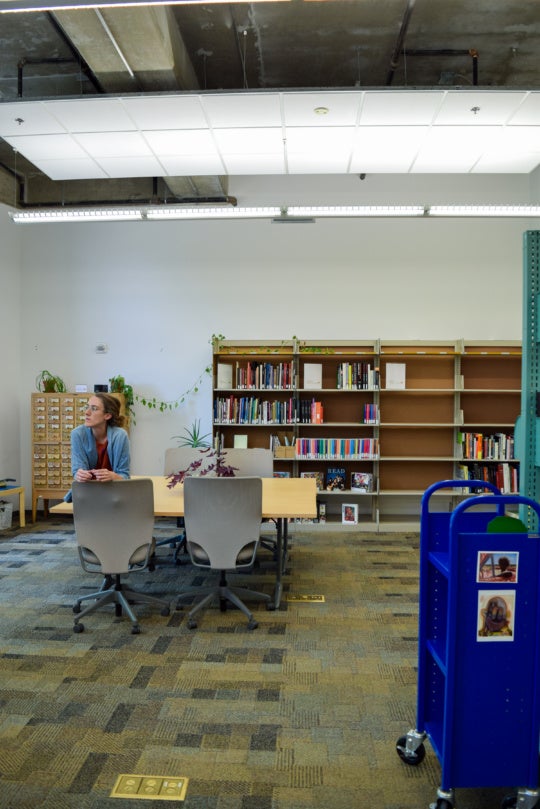
Look down at the sidewalks in Atlanta this month and you may see a peculiar looking chalk “X” at your feet. As part of Sexual Assault Awareness month, artist and advocate Jessica Caldas is carrying around a timer set to go off every 107 seconds, which is how often someone in the US faces sexual assault. She makes chalk marks to commemorate these anonymous victims, as well as to start a conversation about sexual violence. The project #every107seconds beautifully combines social practice, memorial art, and minimalism into a simple yet powerful piece. It’s part of a series of events and performances Caldas has planned over the coming month, including her exhibition opening tonight at Mammal Gallery.
This was one of the most interesting interviews I’ve ever done, because sitting with Caldas while her timer went off and watching the marks accumulate was a very moving, thought-provoking experience. In this condensed interview, I’ve left the timer beeps where they occurred in our conversation.
Matthew Terrell: So we are here to talk about your chalking project. Can you start off by … [BEEP BEEP BEEP]. Can you describe the project?
Jessica Caldas: This project is called #every107seconds or 107 Seconds. The hashtag is part of the name, because although it’s a physical, social practice piece, it also occurs primarily through social media, and that’s how a lot of people follow it or get access to it. So it’s an important element of the title.
This is the second year I’ve done the project. I started last year, at the beginning of April 2015, for Sexual Assault Awareness month. It’s a very easy premise, based on a statistic that in the United States someone is sexually assaulted or faces an attempted sexual assault every 107 seconds. And that’s regardless of gender or sexual orientation. That’s a little bit less than two minutes. People have said, “Two minutes is a lot,” and I remember thinking, “But it’s actually less than that.” That’s how pervasive it is, it’s even less than this number that people know.

I set a few rules right off the bat, because I wanted to actually finish it. So I got myself a timer, and every time I left my home, and anytime I was in a public space, I would turn the timer on. It was set to a minute and forty-seven seconds, which is 107 seconds. And so the timer runs down — it’s automatic — when it beeps I stop wherever I am and I make a chalk X [BEEP BEEP BEEP] and then I start the timer over, and that’s the project. If I’m inside my home, or a coffee shop, or a theater, or somewhere like a building that’s not a public space I don’t worry about it. The timer goes off, and I just continue. But as long as I’m outside, I have to do it. So that enables me to sleep, it enables me to work if I have a job, things like that.
MT: Why is this project meaningful to you?
JC: I am a survivor of sexual assault. It’s actually the 10-year anniversary of my assault. And last year, I began confronting that trauma head on, because I’d done all these interviews with sexual assault survivors for a series of mixed media drawings that I completed, and the process was actually much more difficult than I’d thought it would be. I’ve worked with a lot of gender-based violence issues. So I did all these interviews thinking I’d be fine, and it turned out that I had a really strong reaction to these interviews in particular, which I wasn’t expecting. This meant that these pieces I was supposed to complete in three months took me almost a year to finish. I was struggling a lot to figure out why, because I thought I’d gotten over this whole thing. So, the genesis for this project really occurred in the midst of me figuring all that out.

And so it was very [BEEP BEEP BEEP] important for me to personally do it, which is why it didn’t matter to me that I didn’t create a lot of press for it, or do anything other than post constantly throughout the month. It was almost as much for me as it was for anybody else.
MT: How do you classify this? Is this performance, is this social practice? What is this?
JC: I call this social practice, but there’s definitely a performative aspect to it. The art obviously is not so much in these chalk Xs, these are very simple symbols. And honestly, without context, it doesn’t have a lot of meaning. The art is in the starting of the conversation. People see me making the Xs, and there’s this really interesting thing: Are people going to stop you? Are they going to ask you what you’re doing?
MT: Do they?
JC: Sometimes they do. Sometimes they don’t though. But sometimes I can see people wanting to ask me but not stopping me. I don’t purposefully engage people. I wait for people to engage me. That’s a part of it. It’s not a strict rule, like some of the other rules, but it is an unspoken rule for me. I wait for people to engage me, because it is a hard thing to talk about. Part of the idea of this piece and other pieces that I’ve done is that I’m inviting people to talk to me. They’re curious about what I’m doing. And there is something playful about chalk — people don’t usually suspect anything heavy or unusual. When they ask and I explain [BEEP BEEP BEEP] that this is a project I’m doing for Sexual Assault Awareness and that I make a mark every 107 seconds, which is how frequently someone is assaulted in the US, people go, “Oh!”

And, again, this is kind of where the art is. It’s in the conversation, and starting it, and continuing it, and in people’s reactions. Do they want to then ask you more questions? Some people do. People ask really good questions. That’s where I get the most joy out of it. Because if I’m on my game, I have all my statistics in my head, I have a lot of personal experience, and experiences with advocacy. So I can answer people’s questions. Or people will ask, “What can I do?” Which is actually not a question I get as much as I’d like. People ask a lot of questions, such as, “How bad is it really?” Or if there’s big news stories, they’ll say, “Well, what about that thing in the news?” And then I get to have all these great conversations with people about something that’s usually stigmatized and discussed publicly very often, which is kind of the point, as well.
MT: Tell me about the ephemerality of chalk. We’ve had a lot of rain recently, and it washes away. How do you feel about that in relation to this project?
JC: This project is easier than some of the others I’ve done, where I do larger, more time-consuming drawings with chalk that then get washed away. I’ve thought a lot about that. [BEEP BEEP BEEP] I think, conceptually, I like the idea that it does get washed away, and then there’s this hope for someone who’s an advocate for an issue like this. There’s a sort of despair and then hope. Are you working toward nothing? Is this really something that’s actionable, that you can really create solutions for?
On my down days, I’m like, what’s the point? This shit is never going to change. That doesn’t happen often for me, but there are those moments and those fears, especially when you hear certain things, or people say things that are super victim-blaming, or just so wrong. I know that they just don’t know how wrong it is. But, for the most part, I believe that this work — not this chalk marking, but the work that advocates do, that activists do — does create real change and possibility for a solution. And the conversations that people have where they learn are moments where, possibly, change is going to happen.
The hope would be that every year I would make less X marks.
MT: What are the [BEEP BEEP BEEP] good surprises that you’ve seen in this project?
JC: People picking it up for themselves is really nice. When people post a photo that shows they’ve started making some marks, that they’re engaging the project on their own — that always makes me really happy. My little sister did that last year. She’s 13. I have a friend who is a huge advocate. He participated really strongly in the Carry That Weight campaign, and he did it for a week. He was sending me photos of his own marks that he was making and posting them online. And random folks that I would never have expected — they’d see one mark that I had made somewhere, and they’d take a picture of it, and tag it, or they make their own. That’s always really nice to see.

MT: As an advocate, can you speak to what are the specific areas of need right now when it comes to sexual assault? What do we need to be dealing with? What do we need to be talking about? What resources do we need in this ecosystem, in this world right now?
JC: Well, the rape kit backlog is a big thing that RAINN has been dealing with for years.
MT: What is RAINN?
JC: The Rape and Incest National Network. They’ve been big proponents of solving this rape kit backlog issue for years, actually. I don’t know why [BEEP BEEP BEEP] recently it’s gotten so much attention.
MT: And it is a national issue?
JC: It is a national issue. There’s probably hundreds of thousands of untested kits in the US. The fact that some states are starting to take that seriously as a legislative issue that they can change is great. Because what that does is also signal a culture shift around rape and sexual assault, which I think is the bigger issue. Which I then think is connected to sex education.

MT: Can you speak to the idea of artist as advocate, and how people respond to that — if they understand it, if they’re confused by it, if they praise it, if they’re like, “Oh why don’t you just paint a nice pretty picture?”
JC: I have really positive interactions with people as an artist advocate. I don’t know that everybody does. I think that some people are like, “Well, art should just be pretty” and things like that. Or, “art should be something you hang on your wall. It doesn’t need to be political.” And there are artists who even feel that way. I think that’s valid, and I think that there are many different, valid ways to be an artist. This is just the path that I have chosen, and that I feel passionate and invigorated by, and that feels necessary for my life.
I think other advocates and organizers perceive me or my work well, because it’s a creative way of engaging audiences, which is, I think, probably one of the biggest challenges for advocates. You have to have these serious, heavy, or whatever conversations with people about things that not everybody wants to talk about. So art provides a path for that conversation that’s a little bit different. I think I’m often well received by advocates and organizers. [BEEP BEEP BEEP] I think the struggle I have is with myself. I think a lot about how to change these awareness education projects into something more actionable.
MT: Any final thoughts?
JC: If people feel so inclined, pick up a piece of chalk and just sit outside for an hour, and make a couple Xs and think about what that means, and think about what you can do. Check out RAINN’s website, it’s really great. The Rape and Incest National Network. Look around, see what’s going on in your community. Most communities have sexual assault awareness and rape prevention centers. There’s the Grady Rape Crisis Center. I know that the crisis centers in and around Atlanta could always use more volunteers. There’s always something that can be done.
Jessica Caldas’s exhibition “Love/d & Sex/ed” opens tonight at Mammal Gallery and runs through May 31. On Saturday, April 16, a series of performances, called “Conversations on Sex,” will be presented by various artists. Programming on subsequent Saturdays includes “Conversations on Love,” “Conversations on the Body,” and “Becoming hu-MAN: Voices to Help End Rape Culture.” Click here for the full schedule.
Matthew Terrell writes, photographs, and creates videos in the fine city of Atlanta. His work can be found regularly on the Huffington Post, where he covers such subjects as the queer history of the South, drag culture, and gay men’s health issues. He was a participant in Cycle 2 of BURNAWAY’s Art Writers Mentorship Program.




